List of Filipino inventions and discoveries
| Part of a series on the |
| Culture of the Philippines |
|---|
 |
| People |
| Languages |
| Traditions |
| Cuisine |
| Festivals |
| Religion |
| Art |
| Literature |
|
Music and performing arts |
|
Monuments |
|
This article discusses Filipino inventions and discoveries the details the indigenous arts and techniques, cultural inventions, scientific discoveries and contributions of the people of Philippine islands — both ancient and modern state of the Philippines.
Since ancient times, Filipinos has accumulated knowledge and developed technology stemmed from necessities; from naval navigation knowledge, traditional shipbuilding technology, textile techniques, food processing to Architecture, indigenous arts and techniques, cultural inventions, scientific discoveries and contributions of the people of Philippine archipelago — both ancient and modern state of the Philippines.
Fashion
- The barong Tagalog (or simply baro, but commonly incorrectly called barong), an embroidered formal garment of the Philippines. It is very lightweight and worn untucked (similar to a coat/dress shirt), over an undershirt. It is usually worn by men during weddings, banquets, and other such formal events. Women wearing the barong Tagalog is uncommon, but not unheard of. The term "barong Tagalog" literally means "a Tagalog dress" in the Tagalog language. The baro was popularized as formal wear by Philippine President Ramon Magsaysay, who wore it to most official and personal affairs, including his inauguration as president.
- The Baro’t saya (also known as Filipiniana) is an embroidered dress and is worn by women. The name is a contraction of the
Tagalog words barò at saya, meaning "dress (blouse) and skirt".[1][2]
- Bahag is a loincloth that was commonly used throughout the Philippines before the arrival of European colonizers, and which is used by some indigenous tribes of the Philippines today - most notably the Cordillerans in Northern Luzon.[3][4]
Literature and arts
- The Hudhud consists of narrative chants performed mainly by elder Ifugao women usually during the rice sowing season, at harvest time and at funeral wakes and rituals.[5]
- Pabása is a Catholic devotion in the Philippines popular during Holy Week involving the uninterrupted chanting of the Pasyón, an early 16th-century epic poem narrating the life, passion, death, and resurrection of Jesus Christ.[6] The verses are based on the bible and practiced every holy week.
Science and medicine

Weapons
Swords and bladed weapons
- The panabas is a large, forward-curved sword, used by certain ethnic groups in the southern Philippines. Its length varied from two to four feet, and was either wielded with one hand or with both. It was used as a combat weapon, as an execution tool, and as a display of power. Occasional use as an agricultural and butchering tool has also been noted. The sword's name is a shortening of the word "pang-tabas", which means "chopping tool". As such, its etymological origins are the root word tabas ("to chop off").
- The Balisong (a type of butterfly knife or fan knife) is a folding pocket knife with two handles counter-rotating around the tang such that, when closed, the blade is concealed within grooves in the handles. It is sometimes called a Batangas knife, after the Tagalog province of Batangas, where it is traditionally made. In the hands of a trained user, the knife blade can be brought to bear quickly using one hand. Manipulations, called "flipping" or "fanning", are performed for art or amusement.
- The barong or barung, is a short sword with a leaf-shaped blade, widely used in the island of Mindanao.
- The gunong or punyál (also known as puñal de kris or kris knife) is a knife from Mindanao. It is essentially a diminutive form of the larger kalis or kris. The gunong serves both as a utility knife and as a thrusting weapon used for close quarter fighting – usually as a last defense. It is most often associated with the ethnic Maranao, among whom the gunong was traditionally carried by both sexes. The weapon is generally tucked into the back of a waist sash.
- The kampilan is a type of single-edged long sword, used on the islands of Mindanao, Visayas, and Luzon. The kampilan has a distinct profile, with the tapered blade being much broader and thinner at the point than at its base, sometimes with a protruding spikelet along the flat side of the tip and a bifurcated hilt which is believed to represent a mythical creature's open mouth. A notable wielder of the kampilan was Lapu-Lapu (the king of Mactan) and his warriors, who defeated the Spaniards and killed Portuguese explorer Ferdinand Magellan at the Battle of Mactan in 1521. The mention of the kampilan in ancient Filipino epics originating from other non-Muslim areas such as the Hiligaynon Hinilawod and the Ilocano Biag ni Lam-Ang is possible evidence for the sword's widespread usage throughout the archipelago during pre-Hispanic times
- The kalis is a type of double-edged Filipino sword, often with a "wavy" section, similar to a keris. Just like the keris, the Kalis's double-edged blade can be used for both cutting and thrusting; except that the Kalis is much larger than most Kerises, making it a sword rather than a dagger. The wavy portion of the kalis is said to be meant to facilitate easier slashing in battle - since a straight edge tends to get stuck in the opponent's bones, the wavy portion allows the kalis' bearer to more easily pull the weapon out of his opponent's body.[8]
Firearms/projectile weapons
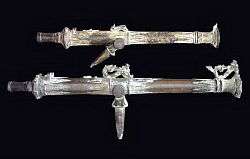
- The lantaka (also known as kanyon in Tagalog) were a type of bronze swivel gun mounted on merchant vessels travelling the waterways of Malay Archipelago. Its use was greatest in precolonial South East Asia especially in Malaysia, the Philippines, and Indonesia. The guns were used to defend against pirates demanding tribute for the local chief, or potentate. Although most lantaka weighed under two hundred pounds, and many only a few pounds, the largest ones exceeded a thousand pounds, and some weighed over a ton. Many of these guns were mounted on swivels and were known as swivel guns. The smaller ones could be mounted almost anywhere including in the rigging. Medium-sized cannon were frequently used in reinforced sockets on the vessel's rails and were sometimes referred to as rail guns. The heaviest swivel guns were mounted on modified gun carriages to make them more portable.[9] High quality metal casting, artillery, and other metal works had been traditions throughout the ancient Philippines. The metal smith, or panday piray of Pampanga was skilled at making weapons, and many individuals with the surnames Viray and Piray are said to be descendants of people who were once members of the guild of smiths who followed the tradition of the panday pira.[10] Ancient peoples used small arquebuses, or portable cannons made up of bronze. Larger cannons, on the other hand, were made of iron and resembling culverins provided heavier firepower. The iron cannon at Rajah Sulaiman III's house was about 17 feet long and was made from clay and wax moulds.[10]
Construction and civil engineering

- The Igorots built forts made of stone walls that averaged several meters in width and about two to three times the width in height around 2000 BC.[11]
- The Idjang is triangular hil-to citadel of the Ivatan people of the northern islands of Batanes, these idjangs are built fortifications to protect themselves during times of war. They built their so-called idjangs on hills and elevated areas.[12] These fortifications were likened to European castles because of their purpose. Usually, the only entrance to the castles would be via a rope ladder that would only be lowered for the villagers and could be kept away when invaders arrived. [12]
- Torogan was a symbol of high social status. Such a residence was once a home to a Lakan , Rajah's sultan or Datu in the Philippine archipelago a Torogan is elevated above the ground by its columns cut from trees of huge girth. Its walls are covered with plywood sticks and the roof thatched with dried coconut leaves. There is no interior partition, so it appears as a huge hall. Apart from the basic elements of this structure, it is intricately engraved with the flowing geometries of the Maranaw design system called okir. A Torogan will never be complete without the legendary bird, Sarimanok being displayed inside. Furniture is also common among Maranaws. one of the example was the Kawayan Torogan, built by Sultan sa Kawayan Makaantal in Bubung Malanding, Marantao, Lanao del Sur, the last remaining habitable Torogan, was declared as a National Cultural Treasure by the National Museum of the Philippines in 2008.[13]
Music and instruments

- OPM include musical performance arts in the Philippines or by Filipinos composed in various genres and styles. The compositions are often a mixture of different Asian, Spanish, Latin American, American, and indigenous influences.[14] [15]
- The Kudyapi is a Philippine two-stringed, fretted boat-lute. It is the only stringed instrument among the people of Visayas and Mindanao, and one of several among other groups such as the Maranao and Manobo. It is four to six feet long with nine frets made of hardened beeswax. The instrument is carved out of solid soft wood such as that from the jackfruit tree. The kudyapi has been found among groups such as the Visayans whose prevalence just like the kubing and other musical instruments are and/or were found in other parts of the Philippines.[16][17][18][19][20][21]
- Palendag, also called Pulalu (Manobo[22] and Mansaka), Palandag (Bagobo),[23] Pulala (Bukidnon) and Lumundeg (Banuwaen) is a type of Philippine bamboo flute, the largest one used by the Maguindanaon. A smaller type of this instrument is called the Hulakteb (Bukidnon).[24] A lip-valley flute, it is considered the toughest of the three bamboo flutes (the others being the tumpong and the suling) to use because of the way one must shape one's lips against its tip to make a sound.[25] The construction of the mouthpiece is such that the lower end is cut diagonally to accommodate the lower lip and the second diagonal cut is make for the blowing edge. Among the Bukidnon, a similar instrument with the same construction except that it is three-fourths the length of the palendag, is called the hulakteb.[24]
- gambang, properly called a gambang kayu ('wooden gambang') is a xylophone-like instrument used among peoples of Indonesia and the southern Philippines in gamelan and kulintang, with wooden bars as opposed to the metallic ones of the more typical metallophones in a gamelan. A largely obsolete instrument, the gambang gangsa, is a similar instrument made with metal bars.[26][27]
- gandingan is a Philippine set of four large, hanging gongs used by the Maguindanao as part of their kulintang ensemble. When integrated into the ensemble, it functions as a secondary melodic instrument after the main melodic instrument, the kulintang. When played solo, the gandingan allows fellow Maguindanao to communicate with each other, allowing them to send messages or warnings via long distances. This ability to imitate tones of the Maguindanao language using this instrument has given the gandingan connotation: the “talking gongs.”[28]
Transportation and mobility

Marine vessels

- The balangay was the first wooden marine vessel ever excavated in Southeast Asia. It is also known as the Butuan boat, as nine specimens of these boats, dating back to pre-Hispanic times (the earliest being in 320 CE), were discovered in 1976, Butuan, Mindanao. It is believed that the Austronesians migrated to the Philippine archipelago, riding the balangay. When the first Spaniards arrived in the 16th century, they found the Filipinos living in well-organized independent villages called "baranggáy". The name barangay originated from balangay, the Austronesian word for "sailboat".
- The Karakoa was an ancient warship in the Philippines by the Visayan and Kapampangan people built out of plank fastened with stakes, fitted with accoutrements necessary for searading (mangayaw), slaves and occasional bride.[29] Pedro Chirino, a Spanish friar and a historian, said on his book Relacion de las Islas Filipinas that Karakoa was three times faster than a Spanish Galleon, in the book detailed how friar Francisco Alcina a keen shipwright admired the efficiency of the vessels crafted by the native Visayans, There were 2,000 Kapampangan belligerents in the Battle of Bangkusay who boarded on 40 Karakoas.[30]
- The vinta (locally known as lepa-lepa or sakayan) is a traditional boat, made by ethnic Bajau and Tausūg, living in Mindanao, the Sulu archipelago, North Kalimantan (Indonesia), and Sabah (Malaysia). These boats, sporting a single, colorful sail, are used for inter-island transport of people and goods. Zamboanga City is known for these vessels.
Land transport
- The Jeepney, a modified military jeep, is the most common form of transportation in the country today. After independence from the United States was declared in 1946, there was a surplus of American military jeeps in the country. Filipinos then modified these vehicles to serve as makeshift buses. Since then, this ubiquitous vehicle has faced a lot of innovative transformations until the modern “E-Jeepney” was finally introduced in Metro Manila and Bacolod.
- The Marine Multi-purpose Vehicle or MMPV uses independent suspensions and portal geared hubs similar to portal axles to make for a full 16 inches of ground clearance. The vehicle also has disc brakes on all four wheels, and four-wheel double-wishbone suspension. The brake discs are not mounted at the wheels as on conventional automobiles, but are inboard, attached to the outside of each differential. The front and rear differentials are Torsen type, and the center differential is a regular, lockable type. Created by the Philippine Marine Corps to replace M151 jeeps in service as they are hard to maintain with problems concerning availability of spare parts.
Food techniques
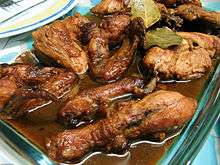

- Adobo (meaning "marinade," "sauce" or "seasoning") is the name of a popular dish and cooking process in Filipino cuisine that involves meat, seafood, or vegetables marinated in a sauce of vinegar and garlic, browned in oil, and simmered in the marinade. Although it has a name taken from the Spanish, the cooking method is indigenous to the Philippines. Dishes prepared in this manner eventually came to be known by this name, with the original term for the dish now lost to history.[31][32]
Before the Spaniards came, early Filipinos cooked their food minimally by roasting, steaming or boiling. To keep it fresh longer, food was often cooked by immersion in vinegar and salt. Thus, early Filipinos could have been cooking its meat in vinegar, which is the basic process in making adobo. The process of adobo was an ancient method dating back to the Classical Period of preserving the pork and chicken meats. since there was no refrigeration at the time.[33]
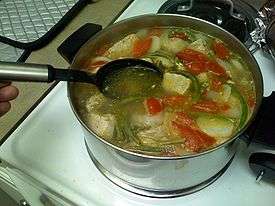
- Sinigang is a Filipino soup or stew characterized by its sour and savory flavor most often associated with tamarind (sampalok). It is one of the popular dishes in Philippine cuisine.
- The recipe for banana catsup was created by Maria Orosa y Ylagan. Banana catsup is used as a substitute for tomato catsup, widely popularized by Max's, one of the biggest fried chicken restaurant chains in the Philippines. Orosa also experimented with foods native to the Philippines and formulated food products like calamansi nip, a desiccated and powdered form of calamansi that could be used to make calamansi juice, and a powdered preparation of soya-beans called Soyalac, a "magic food" preparation which helped save the lives of thousands of Filipinos, Americans, and other nationals who were held prisoner in different Japanese concentration
camps.
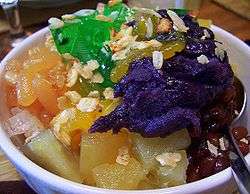
- Halo-halo (Tagalog: [haluˈhaloʔ], "mixed together") is a popular Filipino dessert with mixtures of shaved ice and evaporated milk to which are added various ingredients, including boiled sweet beans, coconut, sago, gulaman (agar jelly), tubers and fruits. It is served in a tall glass or bowl.[34] The similar Visayan dessert binignit is also referred to as ginataang halo-halo in Tagalog ("halo-halo in coconut milk"), commonly shortened to ginataan. It is made with mostly the same ingredients, although the latter is usually served hot.[35][36]

- Palitaw (from litaw, the Tagalog word for "float" or "rise") is a small, flat, sweet rice cake eaten in the Philippines. They are made from washed, soaked, and ground malagkit (sticky rice). After excess water is let out from the grinding process, scoops of the batter are rolled and flattened to a circular shape and cooked by dropping into boiling water; floating to the surface is an indication that they're done. Before serving, they are dipped in grated coconut, and presented with a separate mix of sugar and toasted sesame seeds.[37]
- Otap (sometimes spelled utap) is an oval-shaped[38] puff pastry in the Philippines, especially common in Cebu where it originated.[39] It usually consists of a combination of flour, shortening, coconut, and sugar. In order to achieve the texture of the pastry, it must undergo an eleven-stage baking process.
- Bibingka is a type of rice cake from the Philippines usually eaten during the Christmas season. It is traditionally cooked in clay pots lined with banana leaves. Bibingka is also used as a general term for desserts made with flour and baked in the same manner. The term can be loosely translated to "[rice] cake".[40]

- Puto is a type of steamed rice cake usually served as snack or as accompaniment to savory dishes such as dinuguan or pancit in Philippine cuisine and believed is to be derived from the Kerala dish puttu. It is eaten as is or with cheese and/or grated fresh coconut, or as an accompaniment to a number of savoury viands (most notably, dinuguan). The most common shape of the putuhán or steamer used in making puto is round, rangingfrom 30 to 60 centimetres (12 to 24 in) in diameter and between 2 to 5 centimetres (0.79 to 1.97 in) deep. These steamers are rings made of either soldered sheet metal built around a perforated pan, or of thin strips of bent bamboo enclosing a flat basket of split bamboo slats (similar to a dim sum steamer basket). The cover is almost always conical to allow the condensing steam to drip along the perimeter instead of on the cakes.[41][42][43]
- kutsinta is a type of steamed rice cake (puto) found throughout the Philippines. It is made from a mixture of rice flour, brown sugar and lye, enhanced with yellow food coloring or annatto extract, and steamed in small ramekins. The cooked cakes are topped with fresh grated meat from mature coconut.[44] It is consumed year-round as a merienda or snack, and is frequently sold along with puto. Unlike its counterpart, which has a doughy texture, kutsina has a jelly-like, chewy consistency. It can be also enhanced by adding latik for a sweeter taste.
- Taho is a Filipino snack food made of fresh soft/silken tofu, arnibal (sweetener and flavoring), and sago pearl (similar to tapioca pearls).[45] This staple comfort food is a signature sweet and taho peddlers can be found all over the country. The Indonesian equivalent of this snack is Tauhue, and the Malaysian equivalent of this snack is called Taufufah.
Modern technologies
- It may take up to 3 days (72 hours) before someone can be rescued from a disaster. Without any life-saving tools on hand, survival rate is significantly reduced. Such was the inspiration behind Rescue 72, a life vest and survival kit in one. Its inventor, Danvic Briones, drew inspiration from the sad fate of several Typhoon Ondoy victims. Rescue 72 is equipped with compartments into which one can put water-proof bags containing first aid kits, water, light snacks, and other items essential for survival.[46]
- Diosdado Banatao developed the first single-chip graphical user interface accelerator that made computers work much faster. This invention has allowed computer users to use graphics for commands and not the usual typed commands in older computers. It has allowed data processing to be a little faster using very little space, with small chips instead of large boards. credited with having developed the first 10-Mbit Ethernet CMOS with silicon coupler data-link control and transreceiver chip, the first system logic chip set for IBM's PC-XT and the PC-AT, and the local bus concept and the first Windows Graphics accelerator chip for personal computers.[47] A three-time start-up veteran, he co-founded Mostron, Chips and Technologies, and S3 Graphics.[48]
- Sitting together on analog circuits and DSP circuits (digital signal processing) on the same silicon and make them work together demonstrated the invention of this one-chip video camera in CMOS. Banatao has received numerous awards, he has co-authored 13 papers and holds six U.S. patents. He has Ph.D. degree from Stanford University in mixed-signal CMOS IC design.[49]
- Eco-G NanoTechnology developed the Eco-G3000, a low-cost and low-maintenance fuel-emission reduction device. It is designed to reduce vehicular gas consumption and toxic emission.[50]
- Justino Arboleda devised the coconet, a sturdy but biodegradable net made from coconut husk.[51]
- The Vazbuilt Modular Housing System, an invention of Edgardo Vazquez, is a concept of a prefabricated or ready-to-build housing system. an easy to build and less time to construct Walls, floors, columns, window panels, and tied beams, with additional implementation which can potentially solved the country housing backlog.[52]
- Marc Loinaz invented the One Chip Video Camera,[49] Ho-hum materials from a personal computer was the beginning of one-chip video camera created by the team of Loinaz at Lucent Technologies. It is small, a size of cigarette lighter, low power and cheap and can be integrated into everything from wristwatches to cars. Contrary to CCDs (charge-coupled devices), which are relatively large, consume large power and are complicated to design, this one chip is also based on silicon chip found on microprocessors and memory devices.
Games and sports
- Game of the Generals, a military-themed board game invented by Sofronio H. Pasola, Jr. The goal of this game is to capture the opponent's flag, or maneuver one's own flag at the end of the board while evading the opponent's soldiers and spies.
- The spike is a volleyball technique developed by Filipino players in the first half of the 20th century and was known as the "Manila Bomb".[53]
Martial arts
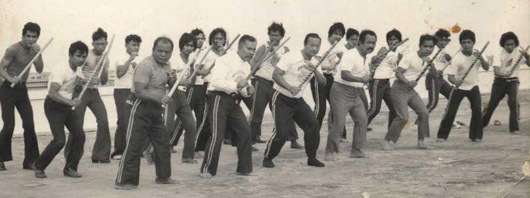
The Eskrima, Arnis,[54] and Kali are umbrella terms for the traditional martial arts of the Philippines ("Filipino Martial Arts," or FMA) that emphasize weapon-based fighting with sticks, knives and other bladed weapons, and various improvised weapons. It is also known as Estoque (Spanish for rapier), Estocada (Spanish for thrust or stab) and Garrote (Spanish for club). In Luzon they may go by the name of Arnis de Mano, Pananandata (use of weapons), Sinawali (Pampanga, "to weave"), Sitbatan (Pangasinan), Didya and Kabaroan (Ilocos region). In the Visayas and Mindanao, these martial arts have been referred to as Eskrima, Kali, Kaliradman, Pagaradman and Kalirongan. Kuntaw and Silat are separate martial arts that have been practiced in the islands. It also includes hand-to-hand combat, joint locks, grappling, and weapon disarming techniques. Although in general, emphasis is put on weapons for these arts, some systems put empty hands as the primary focus and some old school systems do not teach weapons at all.[55]
For all intents and purposes, Eskrima, Arnis and Kali all refer to the same family of Filipino weapon-based martial arts and fighting systems.
Discoveries
- In 1966, Dr. Rodolfo Aquino isolated nine specific breeds of rice for the International Rice Research Institute. His discoveries helped prevent famine in much of Asia.
- Recurring polynya was first discovered by Josefino Comiso, a Filipino physicist working at the NASA Goddard Space Flight Center studying global warming in the Arctic. Comiso located the recurring polynya in the Cosmonaut Sea, south of the Indian Ocean. A polynya is a semi-permanent area of open water in sea ice.[56]
- A method to formulate Erythromycin was discovered by Dr. Abelardo Aguilar A doctor from Iloilo, Aguilar worked for the pharmaceutical company Eli Lilly and Company as a researcher.[57] Then in 1949, he submitted samples of his work to the company’s research team who in 1952 declared the discovery of a new kind of antibiotic.According to the team, the new drug was capable of treating several kinds of infections minus the common side-effects of antibiotics. What’s more, the drug was available to those who were allergic to penicillin.[58] in 1949.
- In 2007, Jayme Navarro of Bacolod discovered a method of converting plastic bags into fuel. It starts by melting the plastics and then taking out the polymers to mix with a catalyst. Pyrolysis will occur soon after to produce hydrocarbon gases. After a several processes of purification, the final output will then be compressed and stored. On average, 5,000 kilos of plastic bags can produce 400 liters of diesel. The discovery was assesed by the DOE and DOST which both attested that the resulting fuel is lower in sulfur and environment-friendly. The invention was finally patented in November 2008.[46]
In urban legends
There are urban legends in the Philippines purporting the supposed invention by Filipinos. These assertions are presented as facts in some academic textbooks in history and science used by Filipino students.[59]
- Fluorescent lamp, said to be invented by a certain Agapito Flores. The name of the invention is supposedly came from the surname of the purported inventor; "Flores" sounding similar to the term fluorescent.[59]
- Yoyo, alleged to have been invented by Filipinos. Some believe that the toy could have been used as a weapon. Nestor Castro of the Department of Anthropology of UP Diliman said that the yoyo was indeed invented as a toy but said that he was uncertain where did the idea of the yoyo as a weapon originated. He pointed out that there are no credible sources stating that the yoyo was invented or not invented by Filipinos.[59]
See also
Notes
- ↑ baro at saya
- ↑ https://books.google.com.ph/books?id=7dSBAAAAMAAJ&q=baro%27t+saya&dq=baro%27t+saya&hl=en&sa=X&ved=0ahUKEwj3xsuej5jWAhUIjpQKHdkZA2gQ6AEIJDAA. Missing or empty
|title=(help) - ↑ Scott, William Henry (1994). Barangay: Sixteenth Century Philippine Culture and Society. Quezon City: Ateneo de Manila University Press. ISBN 978-971-550-135-4.
- ↑ https://books.google.com.ph/books?id=9Cm2mAEACAAJ&dq=brown+skin+minds&hl=en&sa=X&redir_esc=y. Missing or empty
|title=(help) - ↑ "The Hudhud Chants of the Ifugao". UNESCO. Retrieved 2011-01-01.
- ↑ Pazzibugan, Dona. "'Pabasa' is for meditating, not loud wailing". Philippine Daily Inquirer. Retrieved 30 June 2011.
- ↑ "Jose Rodriguez – Research On Leprosy Done By Jose Rodriguez". Inventors.about.com. 2014-03-05. Retrieved 2014-04-19.
- ↑ Raiders of the Sulu Sea (Documentary). Oakfilms3, History Channel Asia. Retrieved 2009-02-08.
- ↑ A History of Greek Fire and Gunpowder. Retrieved 12 December 2014.
- 1 2 Ancient Philippine Civilization. Accessed January 7, 2013.(archived from the original on 2007-12-01}
- ↑ Ancient and Pre-Spanis Era of the Philippines. Accessed September 04, 2008.
- 1 2 http://www.filipiknow.net/archaeological-discoveries-in-the-philippines/
- ↑ Alba, Reinerio (July 22, 2008). "National Museum Declares Maranao Torogan as National Cultural Treasure; Torogan Needs Immediate Rehabilitation". National Commission for Culture and the Arts. Retrieved September 4, 2014.
- ↑
- Clewley, John. "Pinoy Rockers". 2000. In Broughton, Simon and Ellingham, Mark with McConnachie, James and Duane, Orla (Ed.), World Music, Vol. 2: Latin & North America, Caribbean, India, Asia and Pacific, pp 213–217. Rough Guides Ltd, Penguin Books. ISBN 1-85828-636-0.
- ↑ Audio clips: Traditional music of the Philippines. Musée d'ethnographie de Genève. Accessed November 25, 2010.]
- ↑ "5 Traditional Musical Instruments of the Philippines You Should Learn". Pinoy-Culture.com. Retrieved 2016-03-12.
- ↑ de Leon, Jr., Felipe M (2006). "Gawad sa Manlilikha ng Bayan - 1993 Awardee - SAMAON SULAIMAN and the Kutyapi Artist". National Commission For Culture and the Arts. 2002. Archived from the original on 2006-10-10. Retrieved 2006-06-12.
- ↑ Hila, Antonio C (2006). "Indigenous Music - Tuklas Sining: Essays on the Philippine Arts". Filipino Heritage.com. Tatak Pilipino. Retrieved 2006-06-12.
- ↑ Canave-Dioquino, Corazon (2006). "Philippine Music Instruments". National Commission For Culture And The Arts. Archived from the original on 2006-01-17. Retrieved 2006-06-12.
- ↑ de Jager, Fekke (2006). "Kudyapi". Music instruments from the Philippines. Retrieved 2006-06-12.
- ↑ de Leon, Jr., Felipe M (2006). "Gawad sa Manlilikha ng Bayan - 1993 Awardee - MASINO INTARAY and the Basal and Kulilal Ensemble". National Commission For Culture and the Arts. 2002. Archived from the original on 2006-07-16. Retrieved 2006-06-12.
- ↑ Hila, Antonio C (2006). "Indigenous Music - Tuklas Sining: Essays on the Philippine Arts". Filipino Heritage.com. Tatak Pilipino. Retrieved June 12, 2006.
- ↑ de Jager, Fekke (2006). "Palandag". Music instruments from the Philippines. Retrieved 2006-06-12.
- 1 2 Brandeis, Hans (2006). "Musical Instruments for Individual Use". Music and Dance of the Bukidnon-s of Mindanao -A Short Introduction. Retrieved July 7, 2006.
- ↑ Mercurio, Philip Dominguez (2006). "Traditional Music of the Southern Philippines". PnoyAndTheCity: A center for Kulintang - A home for Pasikings. Retrieved February 25, 2006.
- ↑ See, Yee-Seer. (2002). Gambang, Indonesian Gamelan Main Site. Center for Southeast Asian Studies, Northern Illinois University. http://www.seasite.niu.edu/Indonesian/Budaya_Bangsa/Gamelan/Javanese_Gamelan/counter-melody/gambang.htm, accessed 10 March 2006.
- ↑ Mantle Hood. The Nuclear Theme as a Determinant of Pathet in Javanese Music. New York: Da Capo, 1977. Page 240-242 is a discussion of the gambang gangsa
- ↑ Mercurio, Philip Dominguez (2006). "Traditional Music of the Southern Philippines". PnoyAndTheCity: A center for Kulintang - A home for Pasikings. Retrieved February 25, 2006.
- ↑ https://xiaochua.net/tag/karakoa/
- ↑ https://xiaochua.net/tag/karakoa/
- ↑ Ocampo, Ambeth. (February 24, 2009). "Looking Back: 'Adobo' in many forms". Philippine Daily Inquirer. Archived from the original on May 23, 2015. Retrieved August 4, 2010.
- ↑ Rappaport, Rachel (2010). The Everything Healthy Slow Cooker Cookbook. Adams Media. p. 255. ISBN 9781440508486.
- ↑ Cynthia De Castro; Rene Villaroman (2008-07-14). "ADOBO: A History of the Country's National Dish". The Asian Journal Blog. Retrieved 2014-05-12.
- ↑ "The Restaurant". Taldebrooklyn.com. Archived from the original on 2014-07-18. Retrieved 2014-06-09.
- ↑ Merano, Vanjo. "Ginataang Halo-halo Recipe (Binignit)". Panlasang Pinoy.
- ↑ "Ginataan Halo-Halo". Filipino Food Recipes. Retrieved 13 May 2016.
- ↑ Nocheseda, Elmer I. "IN PRAISE OF SUMAN PAST". Tagalog Dictionary. Retrieved 2008-01-26.
- ↑ Otap - Cebu Central - [ Best of Cebu ]
- ↑ BongBong's Piaya & Barquillos - Special Utap
- ↑ "Sweet and Sticky Pinoy Treats: Our Top 10 Kakanin". www.spot.ph. 22 June 2010. Archived from the original on October 8, 2011. Retrieved January 6, 2011.
- ↑ https://books.google.com.ph/books?id=afuBAAAAMAAJ&q=mamon+recipe&dq=mamon+recipe&hl=en&ei=OEJcTbmeDo2uvgOfrfXnDA&sa=X&oi=book_result&ct=result&redir_esc=y
- ↑ https://www.geniuskitchen.com/recipe/puto-168245
- ↑ https://news.abs-cbn.com/lifestyle/12/24/10/filipinos-go-ham-bibingka-christmas/
- ↑ del Mundo, Angelita M. "Emerging Versions of Some Traditional Philippine Rice Food Products." Disappearing Foods: Studies in Foods and Dishes at Risk: Proceedings of the Oxford Symposium on Food and Cookery. 1994
- ↑ "How to make Taho". Archived from the original on 2007-05-03. Retrieved 2007-05-05.
- 1 2 http://www.filipiknow.net/filipino-inventions/
- ↑ http://globalnation.inquirer.net/35239/investing-in-ph-engineering-talent
- ↑ Crisp, Penny & Lopez, Antonio (July 2000). "Making Good in Silicon Valley". Asiaweek. 26 (08).
- 1 2 Sb, Gb (October 4, 2011). "5 Filipino Technology Inventors and Inventions You Should Know : GbSb TEchBlog – Your Daily Pinoy Technology Blog". Gb-Sb.Blogspot.com. Retrieved April 27, 2017.
- ↑ "Filipino invention to help Mongolians breathe free". English.news.mn. 2012-11-12. Retrieved 2014-04-19.
- ↑ "Philippine Inventor Turns Coconut Waste Into Environment-Saver". Terradaily.com. 2006-02-01. Retrieved 2014-04-19.
- ↑ "5 Incredible Filipino Inventions You Might Not Know". Filipiknow.net. August 31, 2013. Retrieved April 27, 2017.
- ↑ Franks, Joel (2 December 2009). Crossing Sidelines, Crossing Cultures: Sport and Asian Pacific American Cultural Citizenship. University Press of America. p. 226. ISBN 9780761847458.
- ↑ Wiley, Mark V. (2000). Filipino Fighting Arts: Theory and Practice. Tuttle Publishing. pp. 1–15. ISBN 0-86568-180-5.
- ↑ Filipino Warrior Arts Research Society Macachor, Celestino S., Macachor met old practitioners who put emphasis or practiced only empty-hands forms when he was learning FMA and during research for his book with Dr. Ned Nepangue, "Cebu Eskrima: Beyond the Myth".
- ↑ "Josefino Comiso – Filipino Physicist". Inventors.about.com. 2014-03-05. Retrieved 2014-04-19.
- ↑ Hibionada, F. Remembering the battle of Dr. Abelardo Aguilar: Cure for millions, deprived of millions.The News Today. Retrieved 22 September 2015
- ↑ http://www.filipiknow.net/abelardo-aguilar-erythromycin/
- 1 2 3 "Ang Pinaka: Ten popular Pinoy urban legends". GMA News. 17 October 2014. Retrieved 7 August 2018.
References
- De La Salle University Library
- National Scientists of the Philippines (1978–1998). Pasig City, Philippines: Anvil Publishing, Inc. 2000. ISBN 978-9712709326.
- Comrade Manokski's ORBAT-
- Timawa.net-
- "Islas de los Pintados: The Visayan Islands". Archived from the original on 2011-09-27.
- "Top 12 Surprising Filipino Inventions You Might Want To Know". Retrieved 11 February 2013.
- "Filipino Scientist and their Inventions". Retrieved 11 February 2013.
- Quintos, Paul. “Balangay.” 101 Filipino Icons. Manila: Adarna House, Inc. and Bench, 2007.
- Casal, Gabriel S., et al. "The Ingenious Filipino Boat." Kasaysayan Volume II: The Earliest Filipinos. Philippines: Asia Publishing Company Limited, 1998.
- archaeology. (accessed on August 10, 2007).
- The Philippine Consulate General – Vancouver, British Columbia Canada. (accessed on August 10, 2007).
External links
- Manokski
- http://definitelyfilipino.com/blog/2012/01/30/top-12-filipino-inventions-you-might-not-know/
- http://inventors.about.com/od/filipinoscientists/Filipino_Inventors_and_Filipino_Scientists.htm
- http://old.blades.free.fr/swords/klewang/kampilan/kampilan.htm
- http://securityarms.com/20010315/galleryfiles/2400/2435.htm
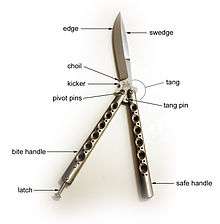
%2C_Mindanao%2C_wood%2C_Honolulu_Museum_of_Art.jpg)